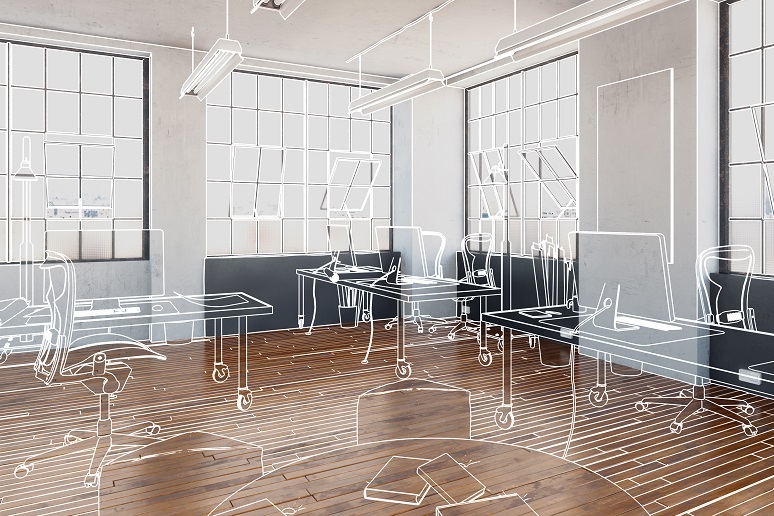In my recent post on solving the tough
challenges of hybrid work, I shared the idea that thinking around office spaces need not be all that different today than it was a year or more ago, as long as the mission was to “give people the ability to work where, when, and how they wanted based on the suitability to the function of their job … .” Certainly, the desire to provide this sort of flexibility led many organizations to create open workplaces that allow easy movement from one space to another and feature plenty of spots for formal and informal dialog.
In a hybrid future, the importance of fostering connections and enabling collaboration is more important than ever. People are going to be expecting spaces that facilitate their collaborative in-person teamwork while at the same time providing the chance for the random encounters that foster a sense of connectedness and delivering a clear message as to their value to the company. Even if an office checked all these boxes prior to the pandemic, the experiences of the past year call for a refresh. After a long year of virtual work, people are looking for more from their workplaces.
Toward that end, office designers at Clive Wilkinson Architects (CWA) this week published their
guidance for the new workplace. They’re calling this guidebook the “
New Workplace Kit of Parts,” and have described 12 office spaces to support and enhance the idea of the connected, collaborative workplace that also allows for “serendipitous encounters and connection to community and culture.” None of these are new concepts, to be sure, “but the pandemic has accelerated these ideas and acts as a catalyst for change,” the firm writes.
So, what does putting a new spin on the concept of the connected, collaborative, culture-building workplace look like according to CWA? Taking the long-term view, a post-COVID workplace centered on collaboration and building community must also account for varied styles of work: “collective and individual, active and quiet — to enhance employee performance and ultimately improve satisfaction and retention,” the firm proposes. “This promises a more diverse, varied and indeed richer environment.”
Like it is with any kit, CWA sees its New Workplace Kit of Parts as a piecing together of various workspaces to fit a company’s needs. These workspaces fall into three categories, each suitable for any employee depending on project at hand — or even mood.
For gatherings and collaborative work, CWA suggests four types of high-energy active spaces, including an all-important lounge-like area, called the Plaza, that allows for a point of reconnection for people who have long been working only virtually; an all-inclusive meeting space, or multipurpose room particularly suitable for long meetings; a pitch room, featuring immersive wall systems for technology pizzazz to wow clients; and the highly collaborative team room designated for co-creation, complete with whiteboards for walls, extra-large monitors, wall displays, and a mix of seating styles.
For those serendipitous encounters and recharging, CWA proposes four types of transition spaces, and says they should be “loaded with functionality to support new ways of working.” For example, companies should allow for the informal, impromptu, technology-free interactions in a space it calls the Booth — and, yes, this is a restaurant reference. “Booths are always popular in restaurants, and we’ve found this rings true in workplaces as well. There’s just something about sinking into a comfortable, high-back booth,” CWA writes.
Lastly, CWA’s New Workplace Kit of Parts features four types of quiet spaces: the Desk, Library, Remote Pod, and Wellness Room. The Library, CWA writes, is the solution to the open office: “Like a reading room in a university library, there is no talking allowed here so employees can get some serious work done. This type of space will be especially popular for those who need quiet to concentrate. Instead of just putting headphones on in the middle of a chaotic open office, employees can find a spot in the Library for a couple of hours and not worry about being disturbed. Remote Pods and other breakout rooms are located immediately adjacent to the Library so it’s easy to jump into a meeting space for a quick phone call or to collaborate with colleagues.”
Many modern, progressive offices will already have had their own versions of active, transitional, and quiet spaces before the pandemic hit. For them, it’s time to look at them with a fresh eye. Do they have the right mix for a hybrid workforce? And for companies that haven’t made collaboration and connectedness a priority previously, now is the time to do so. In either case, CWA hopes that the New Workplace Kit of Parts serves as a source of inspiration for organizations “by offering specific solutions to support their post-pandemic workforces. It’s time to arm people with the tools they need to plan for the future — to “walk the talk” instead of just talking about it.”
I’d say it’s a great reference for anybody thinking about a return to the office, whether responsible for the space itself, the technology within it, or the people occupying it.






